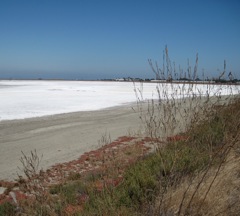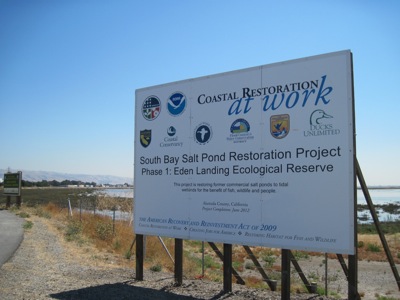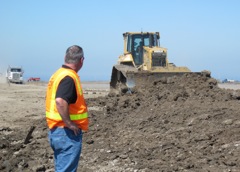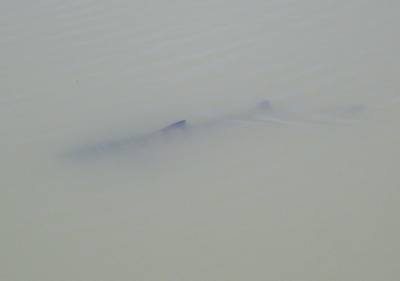Hear our radio feature on wetlands restoration in San Francisco Bay, to be aired Friday afternoon on The California Report.
As my colleague Paul Rogers reported this week, earth has begun to move in the biggest wetlands restoration ever undertaken on the West Coast. This week I took a brief tour of the Eden Landing Ecological Reserve, near Hayward.

Scanning much of the scene, “Eden” wasn’t exactly what came to mind. Vast, white expanses of salt and gypsum deposits are more reminiscent of Utah than a bay estuary. These are the remnants of a once booming salt harvesting industry.
But fueled partially by federal stimulus funding, bulldozers and backhoes are now reshaping levees there as part of the larger South Bay Salt Pond Restoration Project, which will eventually return 630 acres of abandoned salt flats into tidal wetlands at Eden Landing, and thousands more in an arc around the south end of San Francisco Bay.
The project is a consortium of more than a half-dozen federal, state and regional agencies, and the non-profit Ducks Unlimited.

Expanding habitat for plants and wildlife is a central goal of the restoration, but most planners and scientists seem to agree that tidal marshes are an elegant defense against rising sea levels.

Will Travis, executive director of the Bay Conservation and Development Commission, which oversees shoreline development in San Francisco Bay, has explored ideas from as far afield as the Netherlands, looking for ways to cope with rising sea levels. He’s concluded that as low-cost, long-term solutions go, it’s tough to beat the wetlands that are already there (or were there). “Tidal wetlands are about as close to magic as you can get when you’re dealing with sea level rise,” Travis is fond of saying, “Because all wetlands are wonderful for flood protection.”
Wetlands act as giant sponges, helping diffuse high tides and storm surges. Projections for likely degree of sea level rise along the California coast are wide-ranging, but the planning parameter that’s emerged from various reports and used in the state’s climate adaptation strategy, is 16 inches by 2050, and 55 inches by 2100.

In our radio report, produced by Climate Watch intern Rachel Cohen, we talk with wetlands managers from the California Coastal Conservancy and US Fish & Wildlife Service, about what it takes to bring back the marshes.

And there’s more about tidal wetlands and rising seas in an upcoming report from Quest, airing Tuesday, August 24th, at 7:30 p.m. on KQED Public Television.
